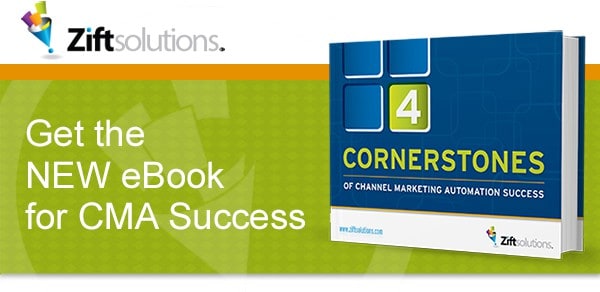Zift’s latest eBook uncovers The 4 Cornerstones of Channel Marketing Success. In this Channel Chatter series, we’ll provide a glimpse into the eBook, which details a direct path for capturing and capitalizing on the promised benefits of Channel Marketing Automation. Read the series intro here if you missed it, catch up with Cornerstone #2 or move forward with Cornerstone #3 below.
Feeding the Content Need
Without a solid content development and execution plan, Channel Marketing Automation (CMA) programs often fail. Maintaining a strong content thread keeps partners engaged and coming back to your CMA platform. Once partners start to get a taste for supplier-provided content, their appetite only grows. If you can’t satisfy their content demands, partners begin to look elsewhere, adoption diminishes and negativity toward CMA tends to emerge.
Content marketing returns high rewards for relatively low cost. Per dollar spent, content marketing produces 3 times more leads than paid search. However, getting the right content to the right people at the right time is an ongoing challenge for those on both sides of the channel. Resource-stretched partners rarely have the time or in-house talent to generate the amount of targeted content required to capture and keep the attention of prospects and customers. At the same time, suppliers may spend thousands to generate content and provide it to partners, only to find that they have limited visibility into what channel partners actually do (or don’t do) with the content they’ve delivered.
Developing a Content Strategy & Marketing Execution Calendar
A strong CMA platform can lift much of the content burden from partners and suppliers, by automating content delivery and providing visibility and usage tracking, including whether content is being ignored or misused by partners. Prior to launching any CMA solution, suppliers must ask themselves several content-related questions. If they don’t, CMA can amplify rather than solve content challenges. Ask yourself:
A strong CMA platform can lift much of the content burden from partners and suppliers, by automating content delivery and providing visibility and usage tracking, including whether content is being ignored or misused by partners. Prior to launching any CMA solution, suppliers must ask themselves several content-related questions. If they don’t, CMA can amplify rather than solve content challenges. Ask yourself:
- Do we have enough available content to adequately respond to partner demand?
- Do we have enough available content to adequately respond to partner demand?
- What are the primary messages we want to convey?
- What are the best materials to provide to partners?
- Does available content align with our product marketing methodologies?
- Are the materials we intend to provide easy to customize for partner marketing?
- How will partners ultimately use the content provided to generate leads and develop a strong marketing presence in their space?
- At what pace will we deliver available content to partners?
Taking time to answer these questions will determine the level of effort required to properly maintain your content pipeline on behalf of your partner community – and go a long way toward defining your content strategy and marketing execution calendar.
Learn more about developing your Content Development & Execution Strategy along with all 4 Cornerstones of Channel Marketing Success by downloading the complete eBook:






